Analysis of Entrepreneurial Opportunities and Orientation - ENTR 101
VerifiedAdded on 2023/01/11
|11
|2844
|26
Report
AI Summary
This report provides a comprehensive analysis of entrepreneurship, focusing on entrepreneurial opportunities and orientation. It begins by defining entrepreneurship and discussing the creation, discovery, and exploitation of opportunities in the market. The report then delves into the five dimensions of entrepreneurial orientation: autonomy, competitive aggressiveness, innovation, proactiveness, and risk-taking. It explores how entrepreneurs can leverage these dimensions to gain a competitive advantage. Furthermore, the report examines key entrepreneurial strategies, including market orientation, customer engagement, and alliance formulation. Through these analyses, the report aims to provide insights into the essential elements of a successful entrepreneurial venture. The author reflects on the application of entrepreneurial orientation dimensions in their personal and professional life, highlighting the importance of innovation and competitive spirit.
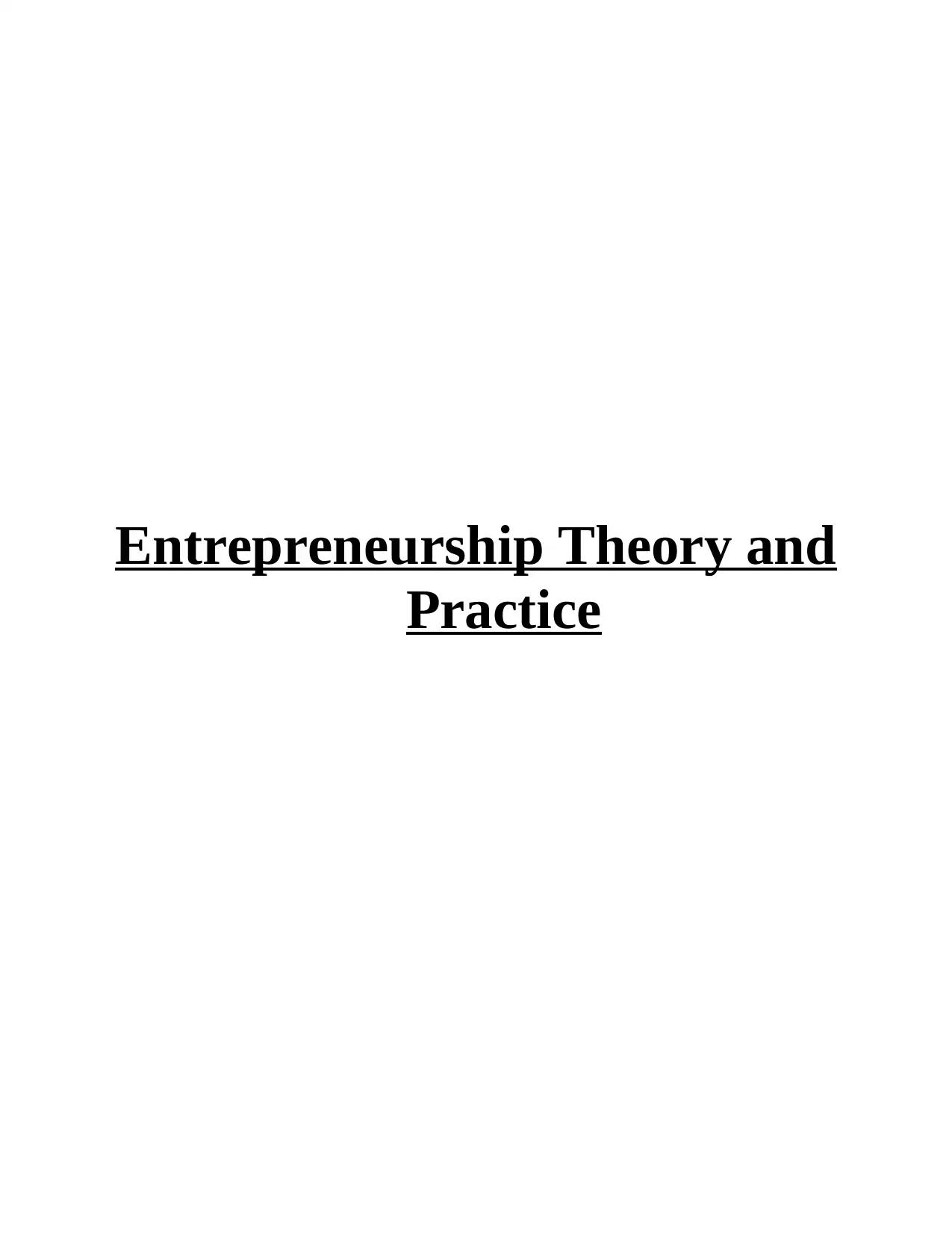
Entrepreneurship Theory and
Practice
Practice
Paraphrase This Document
Need a fresh take? Get an instant paraphrase of this document with our AI Paraphraser


TABLE OF CONTENT
TABLE OF CONTENT...................................................................................................................3
INTRODUCTION...........................................................................................................................4
MAIN BODY..................................................................................................................................4
Question 1a..................................................................................................................................4
Question 1B Five dimension of entrepreneurial orientation........................................................8
Reflection.....................................................................................................................................8
CONCLUSION................................................................................................................................9
REFERENCES..............................................................................................................................10
TABLE OF CONTENT...................................................................................................................3
INTRODUCTION...........................................................................................................................4
MAIN BODY..................................................................................................................................4
Question 1a..................................................................................................................................4
Question 1B Five dimension of entrepreneurial orientation........................................................8
Reflection.....................................................................................................................................8
CONCLUSION................................................................................................................................9
REFERENCES..............................................................................................................................10
⊘ This is a preview!⊘
Do you want full access?
Subscribe today to unlock all pages.

Trusted by 1+ million students worldwide
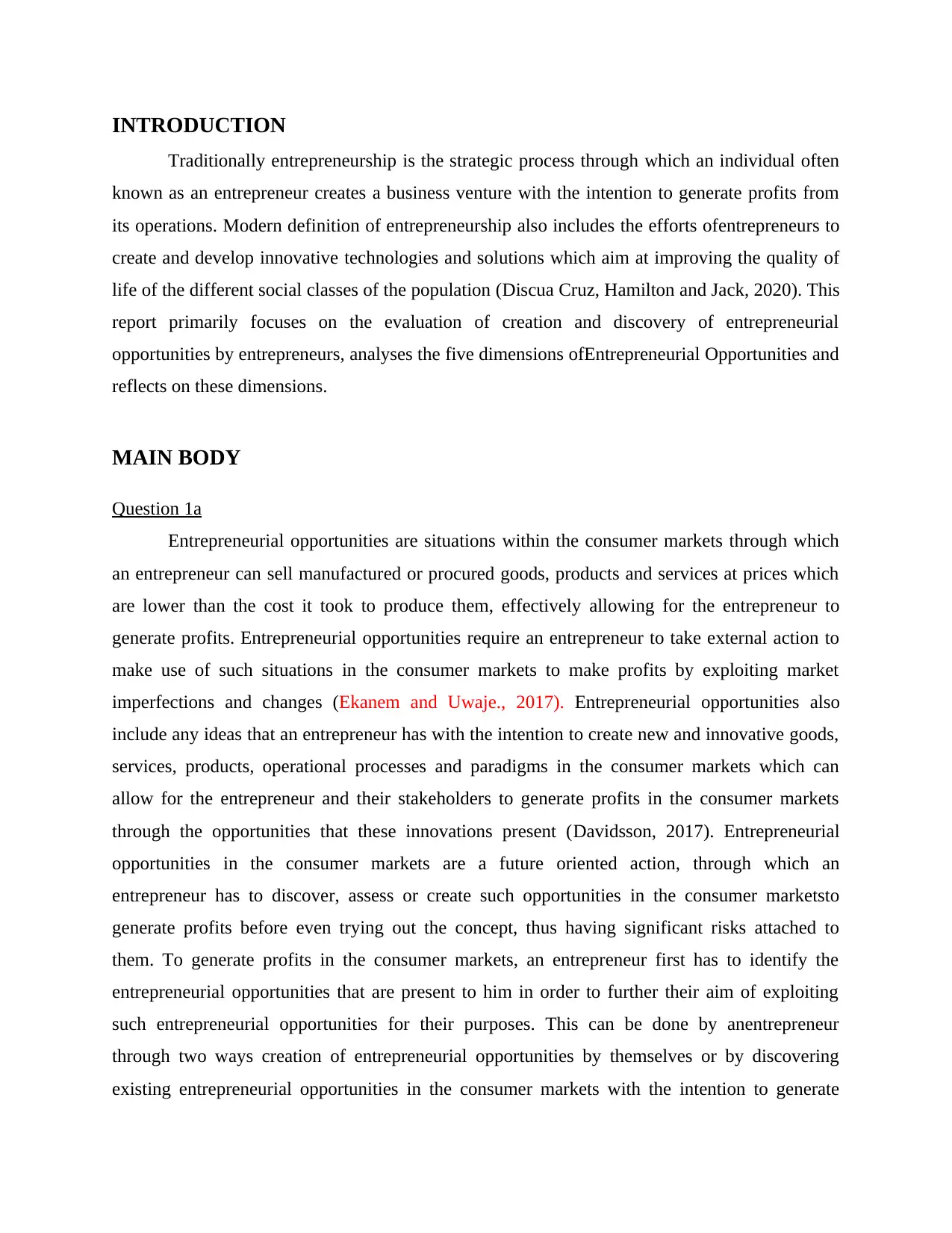
INTRODUCTION
Traditionally entrepreneurship is the strategic process through which an individual often
known as an entrepreneur creates a business venture with the intention to generate profits from
its operations. Modern definition of entrepreneurship also includes the efforts ofentrepreneurs to
create and develop innovative technologies and solutions which aim at improving the quality of
life of the different social classes of the population (Discua Cruz, Hamilton and Jack, 2020). This
report primarily focuses on the evaluation of creation and discovery of entrepreneurial
opportunities by entrepreneurs, analyses the five dimensions ofEntrepreneurial Opportunities and
reflects on these dimensions.
MAIN BODY
Question 1a
Entrepreneurial opportunities are situations within the consumer markets through which
an entrepreneur can sell manufactured or procured goods, products and services at prices which
are lower than the cost it took to produce them, effectively allowing for the entrepreneur to
generate profits. Entrepreneurial opportunities require an entrepreneur to take external action to
make use of such situations in the consumer markets to make profits by exploiting market
imperfections and changes (Ekanem and Uwaje., 2017). Entrepreneurial opportunities also
include any ideas that an entrepreneur has with the intention to create new and innovative goods,
services, products, operational processes and paradigms in the consumer markets which can
allow for the entrepreneur and their stakeholders to generate profits in the consumer markets
through the opportunities that these innovations present (Davidsson, 2017). Entrepreneurial
opportunities in the consumer markets are a future oriented action, through which an
entrepreneur has to discover, assess or create such opportunities in the consumer marketsto
generate profits before even trying out the concept, thus having significant risks attached to
them. To generate profits in the consumer markets, an entrepreneur first has to identify the
entrepreneurial opportunities that are present to him in order to further their aim of exploiting
such entrepreneurial opportunities for their purposes. This can be done by anentrepreneur
through two ways creation of entrepreneurial opportunities by themselves or by discovering
existing entrepreneurial opportunities in the consumer markets with the intention to generate
Traditionally entrepreneurship is the strategic process through which an individual often
known as an entrepreneur creates a business venture with the intention to generate profits from
its operations. Modern definition of entrepreneurship also includes the efforts ofentrepreneurs to
create and develop innovative technologies and solutions which aim at improving the quality of
life of the different social classes of the population (Discua Cruz, Hamilton and Jack, 2020). This
report primarily focuses on the evaluation of creation and discovery of entrepreneurial
opportunities by entrepreneurs, analyses the five dimensions ofEntrepreneurial Opportunities and
reflects on these dimensions.
MAIN BODY
Question 1a
Entrepreneurial opportunities are situations within the consumer markets through which
an entrepreneur can sell manufactured or procured goods, products and services at prices which
are lower than the cost it took to produce them, effectively allowing for the entrepreneur to
generate profits. Entrepreneurial opportunities require an entrepreneur to take external action to
make use of such situations in the consumer markets to make profits by exploiting market
imperfections and changes (Ekanem and Uwaje., 2017). Entrepreneurial opportunities also
include any ideas that an entrepreneur has with the intention to create new and innovative goods,
services, products, operational processes and paradigms in the consumer markets which can
allow for the entrepreneur and their stakeholders to generate profits in the consumer markets
through the opportunities that these innovations present (Davidsson, 2017). Entrepreneurial
opportunities in the consumer markets are a future oriented action, through which an
entrepreneur has to discover, assess or create such opportunities in the consumer marketsto
generate profits before even trying out the concept, thus having significant risks attached to
them. To generate profits in the consumer markets, an entrepreneur first has to identify the
entrepreneurial opportunities that are present to him in order to further their aim of exploiting
such entrepreneurial opportunities for their purposes. This can be done by anentrepreneur
through two ways creation of entrepreneurial opportunities by themselves or by discovering
existing entrepreneurial opportunities in the consumer markets with the intention to generate
Paraphrase This Document
Need a fresh take? Get an instant paraphrase of this document with our AI Paraphraser
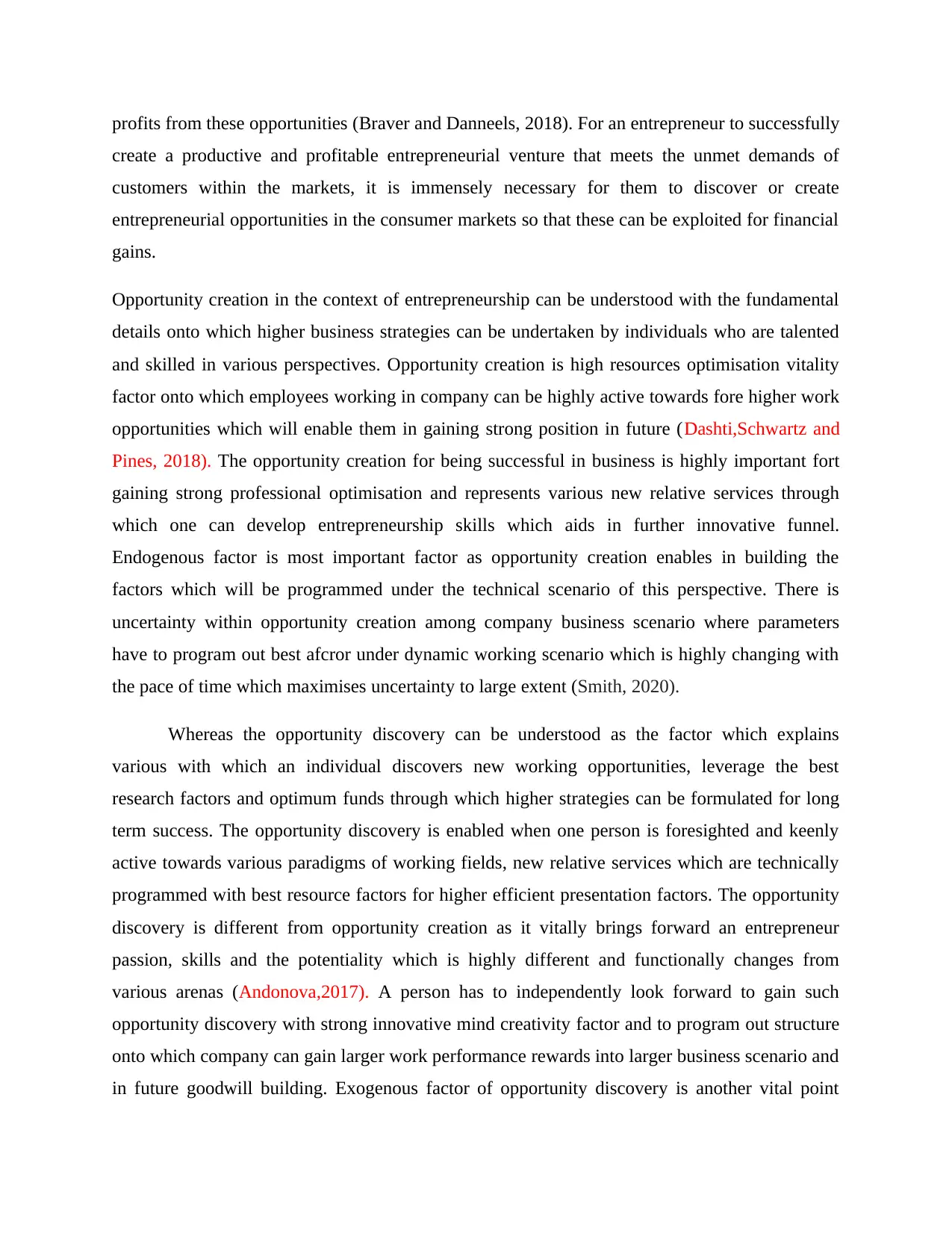
profits from these opportunities (Braver and Danneels, 2018). For an entrepreneur to successfully
create a productive and profitable entrepreneurial venture that meets the unmet demands of
customers within the markets, it is immensely necessary for them to discover or create
entrepreneurial opportunities in the consumer markets so that these can be exploited for financial
gains.
Opportunity creation in the context of entrepreneurship can be understood with the fundamental
details onto which higher business strategies can be undertaken by individuals who are talented
and skilled in various perspectives. Opportunity creation is high resources optimisation vitality
factor onto which employees working in company can be highly active towards fore higher work
opportunities which will enable them in gaining strong position in future (Dashti,Schwartz and
Pines, 2018). The opportunity creation for being successful in business is highly important fort
gaining strong professional optimisation and represents various new relative services through
which one can develop entrepreneurship skills which aids in further innovative funnel.
Endogenous factor is most important factor as opportunity creation enables in building the
factors which will be programmed under the technical scenario of this perspective. There is
uncertainty within opportunity creation among company business scenario where parameters
have to program out best afcror under dynamic working scenario which is highly changing with
the pace of time which maximises uncertainty to large extent (Smith, 2020).
Whereas the opportunity discovery can be understood as the factor which explains
various with which an individual discovers new working opportunities, leverage the best
research factors and optimum funds through which higher strategies can be formulated for long
term success. The opportunity discovery is enabled when one person is foresighted and keenly
active towards various paradigms of working fields, new relative services which are technically
programmed with best resource factors for higher efficient presentation factors. The opportunity
discovery is different from opportunity creation as it vitally brings forward an entrepreneur
passion, skills and the potentiality which is highly different and functionally changes from
various arenas (Andonova,2017). A person has to independently look forward to gain such
opportunity discovery with strong innovative mind creativity factor and to program out structure
onto which company can gain larger work performance rewards into larger business scenario and
in future goodwill building. Exogenous factor of opportunity discovery is another vital point
create a productive and profitable entrepreneurial venture that meets the unmet demands of
customers within the markets, it is immensely necessary for them to discover or create
entrepreneurial opportunities in the consumer markets so that these can be exploited for financial
gains.
Opportunity creation in the context of entrepreneurship can be understood with the fundamental
details onto which higher business strategies can be undertaken by individuals who are talented
and skilled in various perspectives. Opportunity creation is high resources optimisation vitality
factor onto which employees working in company can be highly active towards fore higher work
opportunities which will enable them in gaining strong position in future (Dashti,Schwartz and
Pines, 2018). The opportunity creation for being successful in business is highly important fort
gaining strong professional optimisation and represents various new relative services through
which one can develop entrepreneurship skills which aids in further innovative funnel.
Endogenous factor is most important factor as opportunity creation enables in building the
factors which will be programmed under the technical scenario of this perspective. There is
uncertainty within opportunity creation among company business scenario where parameters
have to program out best afcror under dynamic working scenario which is highly changing with
the pace of time which maximises uncertainty to large extent (Smith, 2020).
Whereas the opportunity discovery can be understood as the factor which explains
various with which an individual discovers new working opportunities, leverage the best
research factors and optimum funds through which higher strategies can be formulated for long
term success. The opportunity discovery is enabled when one person is foresighted and keenly
active towards various paradigms of working fields, new relative services which are technically
programmed with best resource factors for higher efficient presentation factors. The opportunity
discovery is different from opportunity creation as it vitally brings forward an entrepreneur
passion, skills and the potentiality which is highly different and functionally changes from
various arenas (Andonova,2017). A person has to independently look forward to gain such
opportunity discovery with strong innovative mind creativity factor and to program out structure
onto which company can gain larger work performance rewards into larger business scenario and
in future goodwill building. Exogenous factor of opportunity discovery is another vital point

which enables in gaining high success with opportunity discovery factor, rationally bringing the
market data under the analysis which is productively strength under these factors. Risk is highly
involved under this factor as discovery of new opportunity for strengthening is important for
larger working scenario building where technical efficiency is important (Levine and Rubinstein,
2017).
The similarities between these two paradigms which are opportunity creation and
opportunity discovery can be understood with the fact that many times an individual who is
foresighted and works with strong passion has the skill to bring forward various analysis
parameters towards which there is functional efficiency lead (Mintrom and Luetjens,2019). Both
these fundamentals can be achieved within business perspectives only when one is highly active
with the changing business scenario, digital media usage and functional operations utilisation
factor through which managers and leaders are technically efficient in programming the whole
structure. Entrepreneur vision and formative actions to bring productive outputs win forthcoming
business scenario highly activates the business functioning ethics into larger scenario building
power. Similarities enable us to understand that both scenarios are an active platform for
entrepreneurs to productively build companies and keenly address new keen ideas for gaining
strong output and synergy for higher outputs which enable leaders to take active steps with
higher innovation and ethical business expansion into larger working scenario (König, Ungerer,
and Baltes, 2016).
Opportunity exploitation factors:
Entrepreneurs have to determine and focus for various exploitation factors while they look
forward for organising their business and relative development factors which are highly
correlated with strong innovative marketing and strategic planning for gaining success on long
term. Customer acquisition and functional efficiency among business partners and advertising
avenues through which companies plan to gain strong success are the most important opportunity
exploitation factors which are under an individual. Passion and perspectives development are the
various scenarios under which person can program out various technical efficiency tools, plan
with strong management activities and work with strong talented skilled employees who are the
most important components under company business framework (Liu, 2017).
market data under the analysis which is productively strength under these factors. Risk is highly
involved under this factor as discovery of new opportunity for strengthening is important for
larger working scenario building where technical efficiency is important (Levine and Rubinstein,
2017).
The similarities between these two paradigms which are opportunity creation and
opportunity discovery can be understood with the fact that many times an individual who is
foresighted and works with strong passion has the skill to bring forward various analysis
parameters towards which there is functional efficiency lead (Mintrom and Luetjens,2019). Both
these fundamentals can be achieved within business perspectives only when one is highly active
with the changing business scenario, digital media usage and functional operations utilisation
factor through which managers and leaders are technically efficient in programming the whole
structure. Entrepreneur vision and formative actions to bring productive outputs win forthcoming
business scenario highly activates the business functioning ethics into larger scenario building
power. Similarities enable us to understand that both scenarios are an active platform for
entrepreneurs to productively build companies and keenly address new keen ideas for gaining
strong output and synergy for higher outputs which enable leaders to take active steps with
higher innovation and ethical business expansion into larger working scenario (König, Ungerer,
and Baltes, 2016).
Opportunity exploitation factors:
Entrepreneurs have to determine and focus for various exploitation factors while they look
forward for organising their business and relative development factors which are highly
correlated with strong innovative marketing and strategic planning for gaining success on long
term. Customer acquisition and functional efficiency among business partners and advertising
avenues through which companies plan to gain strong success are the most important opportunity
exploitation factors which are under an individual. Passion and perspectives development are the
various scenarios under which person can program out various technical efficiency tools, plan
with strong management activities and work with strong talented skilled employees who are the
most important components under company business framework (Liu, 2017).
⊘ This is a preview!⊘
Do you want full access?
Subscribe today to unlock all pages.

Trusted by 1+ million students worldwide
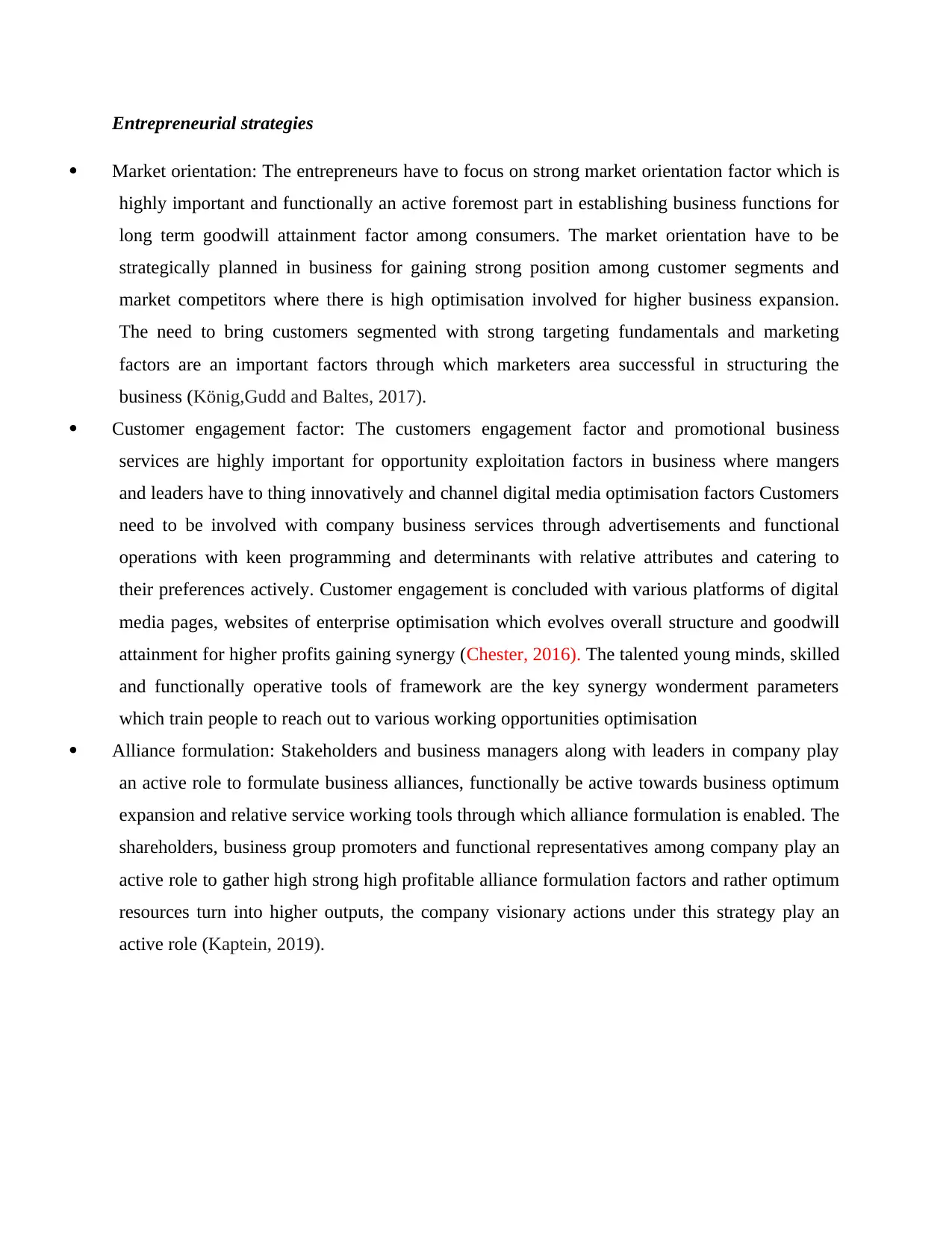
Entrepreneurial strategies
Market orientation: The entrepreneurs have to focus on strong market orientation factor which is
highly important and functionally an active foremost part in establishing business functions for
long term goodwill attainment factor among consumers. The market orientation have to be
strategically planned in business for gaining strong position among customer segments and
market competitors where there is high optimisation involved for higher business expansion.
The need to bring customers segmented with strong targeting fundamentals and marketing
factors are an important factors through which marketers area successful in structuring the
business (König,Gudd and Baltes, 2017).
Customer engagement factor: The customers engagement factor and promotional business
services are highly important for opportunity exploitation factors in business where mangers
and leaders have to thing innovatively and channel digital media optimisation factors Customers
need to be involved with company business services through advertisements and functional
operations with keen programming and determinants with relative attributes and catering to
their preferences actively. Customer engagement is concluded with various platforms of digital
media pages, websites of enterprise optimisation which evolves overall structure and goodwill
attainment for higher profits gaining synergy (Chester, 2016). The talented young minds, skilled
and functionally operative tools of framework are the key synergy wonderment parameters
which train people to reach out to various working opportunities optimisation
Alliance formulation: Stakeholders and business managers along with leaders in company play
an active role to formulate business alliances, functionally be active towards business optimum
expansion and relative service working tools through which alliance formulation is enabled. The
shareholders, business group promoters and functional representatives among company play an
active role to gather high strong high profitable alliance formulation factors and rather optimum
resources turn into higher outputs, the company visionary actions under this strategy play an
active role (Kaptein, 2019).
Market orientation: The entrepreneurs have to focus on strong market orientation factor which is
highly important and functionally an active foremost part in establishing business functions for
long term goodwill attainment factor among consumers. The market orientation have to be
strategically planned in business for gaining strong position among customer segments and
market competitors where there is high optimisation involved for higher business expansion.
The need to bring customers segmented with strong targeting fundamentals and marketing
factors are an important factors through which marketers area successful in structuring the
business (König,Gudd and Baltes, 2017).
Customer engagement factor: The customers engagement factor and promotional business
services are highly important for opportunity exploitation factors in business where mangers
and leaders have to thing innovatively and channel digital media optimisation factors Customers
need to be involved with company business services through advertisements and functional
operations with keen programming and determinants with relative attributes and catering to
their preferences actively. Customer engagement is concluded with various platforms of digital
media pages, websites of enterprise optimisation which evolves overall structure and goodwill
attainment for higher profits gaining synergy (Chester, 2016). The talented young minds, skilled
and functionally operative tools of framework are the key synergy wonderment parameters
which train people to reach out to various working opportunities optimisation
Alliance formulation: Stakeholders and business managers along with leaders in company play
an active role to formulate business alliances, functionally be active towards business optimum
expansion and relative service working tools through which alliance formulation is enabled. The
shareholders, business group promoters and functional representatives among company play an
active role to gather high strong high profitable alliance formulation factors and rather optimum
resources turn into higher outputs, the company visionary actions under this strategy play an
active role (Kaptein, 2019).
Paraphrase This Document
Need a fresh take? Get an instant paraphrase of this document with our AI Paraphraser

Question 1B Five dimension of entrepreneurial orientation
Entrepreneurial orientation are innovative and creative strategies that are formulated by top
management in order to effectively utilise available opportunities to get competitive advantages.
Five dimension of entrepreneurial orientation are autonomy, competitive aggressiveness,
innovation, Pro-activeness and risk taking ability. Autonomy refers to such as organisation where
individual have right to share their innovative ideas, views to top management so that company
can make effective utilisation of available opportunities. Entrepreneur that have tendency to
aggressively compete with other company by improving quality of products, marketing strategies
and enhancing production capacity for growth and expansion of business is known as
competitive aggressiveness (Piva, 2018). Innovativeness is another dimension of entrepreneur
orientation that state individual must be creative and innovative to bring different changes within
industry. Pro -activeness stated that entrepreneur needs to be proactive or plan in advance so that
it can easily accept various external changes of environment and formulate effective strategies
for growth and expansion of business. Pro-activeness also protects company from various
external threats such as change in customer trends, innovation in technologies by effective
formulation of strategies on time. Thus, company can easily gain competitive advantages
expand its market share by meeting needs and preference of customers. Entrepreneur orientation
state that strategies formulate should have ability to bear various risk associated with project. All
such dimension helps top executive to effective implement strategies by making optimum
utilisation of available opportunities in the industry in order to gain competitive advantages
(Lasrado, 2018).
Reflection
From the analysis of five dimension of entrepreneurship orientation I have learnt that various
dimension such as autocracy, innovativeness and competitive aggressiveness has helped me in
my personal and professional life. In my school days I was assign a group project so I have use
autocracy dimension to effectively utilise opportunity to present best project from other people. I
have asked my group member to share their innovative ideas, view about project so that it can be
made innovative and we can get maximum marks as compared to other students. Such autocracy
helps in maintain unity and effective coordination among team member to put their best so that
Entrepreneurial orientation are innovative and creative strategies that are formulated by top
management in order to effectively utilise available opportunities to get competitive advantages.
Five dimension of entrepreneurial orientation are autonomy, competitive aggressiveness,
innovation, Pro-activeness and risk taking ability. Autonomy refers to such as organisation where
individual have right to share their innovative ideas, views to top management so that company
can make effective utilisation of available opportunities. Entrepreneur that have tendency to
aggressively compete with other company by improving quality of products, marketing strategies
and enhancing production capacity for growth and expansion of business is known as
competitive aggressiveness (Piva, 2018). Innovativeness is another dimension of entrepreneur
orientation that state individual must be creative and innovative to bring different changes within
industry. Pro -activeness stated that entrepreneur needs to be proactive or plan in advance so that
it can easily accept various external changes of environment and formulate effective strategies
for growth and expansion of business. Pro-activeness also protects company from various
external threats such as change in customer trends, innovation in technologies by effective
formulation of strategies on time. Thus, company can easily gain competitive advantages
expand its market share by meeting needs and preference of customers. Entrepreneur orientation
state that strategies formulate should have ability to bear various risk associated with project. All
such dimension helps top executive to effective implement strategies by making optimum
utilisation of available opportunities in the industry in order to gain competitive advantages
(Lasrado, 2018).
Reflection
From the analysis of five dimension of entrepreneurship orientation I have learnt that various
dimension such as autocracy, innovativeness and competitive aggressiveness has helped me in
my personal and professional life. In my school days I was assign a group project so I have use
autocracy dimension to effectively utilise opportunity to present best project from other people. I
have asked my group member to share their innovative ideas, view about project so that it can be
made innovative and we can get maximum marks as compared to other students. Such autocracy
helps in maintain unity and effective coordination among team member to put their best so that

common objective can be achieved (Sidek, Mohamad and Mohd, 2019). I have use innovative
and creative ideas to make project successful and differentiate from other students of class. Such
innovative and creative strategies and out of box thinking of our group member helps us in
making effective utilisation of available resource to accomplished desired results (Lisboa,
Skarmeas and Saridakis, 2016). At last dimension of entrepreneur orientation that is competitive
aggressiveness helps us to stay motivated and bring new ideas, innovation so that project can be
made successful and our group can gain competitive advantages over other students within class.
Competitive aggressiveness has helped me to proactively search for new option and method that
can be used to make project effective. As per my view such dimension of entrepreneur
orientation has helped me to learn new and innovative things and enhance my knowledge, skills
to take various decision and risk to gain differentiate position from other people.
CONCLUSION
Based on the findings of the report, it can be effectively concluded that discovery,
creation and exploitation of entrepreneurial opportunities by entrepreneurs with the intention to
create a successful entrepreneurial venture in the business markets is immensely important and
essential process, without which a successful entrepreneurial venture cannot be created. This
report examines the concept of entrepreneurial opportunities and how these are discovered,
created and exploited by entrepreneurs for their operations (Krause,2016).The report
differentiates between opportunity discovery and creation and analyses three strategies that can
help entrepreneurs or firms to effectively exploit the entrepreneurial opportunities. Further the
report assesses the five dimensions of entrepreneurial orientation and provides a reflection on
these based on personal examples.
and creative ideas to make project successful and differentiate from other students of class. Such
innovative and creative strategies and out of box thinking of our group member helps us in
making effective utilisation of available resource to accomplished desired results (Lisboa,
Skarmeas and Saridakis, 2016). At last dimension of entrepreneur orientation that is competitive
aggressiveness helps us to stay motivated and bring new ideas, innovation so that project can be
made successful and our group can gain competitive advantages over other students within class.
Competitive aggressiveness has helped me to proactively search for new option and method that
can be used to make project effective. As per my view such dimension of entrepreneur
orientation has helped me to learn new and innovative things and enhance my knowledge, skills
to take various decision and risk to gain differentiate position from other people.
CONCLUSION
Based on the findings of the report, it can be effectively concluded that discovery,
creation and exploitation of entrepreneurial opportunities by entrepreneurs with the intention to
create a successful entrepreneurial venture in the business markets is immensely important and
essential process, without which a successful entrepreneurial venture cannot be created. This
report examines the concept of entrepreneurial opportunities and how these are discovered,
created and exploited by entrepreneurs for their operations (Krause,2016).The report
differentiates between opportunity discovery and creation and analyses three strategies that can
help entrepreneurs or firms to effectively exploit the entrepreneurial opportunities. Further the
report assesses the five dimensions of entrepreneurial orientation and provides a reflection on
these based on personal examples.
⊘ This is a preview!⊘
Do you want full access?
Subscribe today to unlock all pages.

Trusted by 1+ million students worldwide
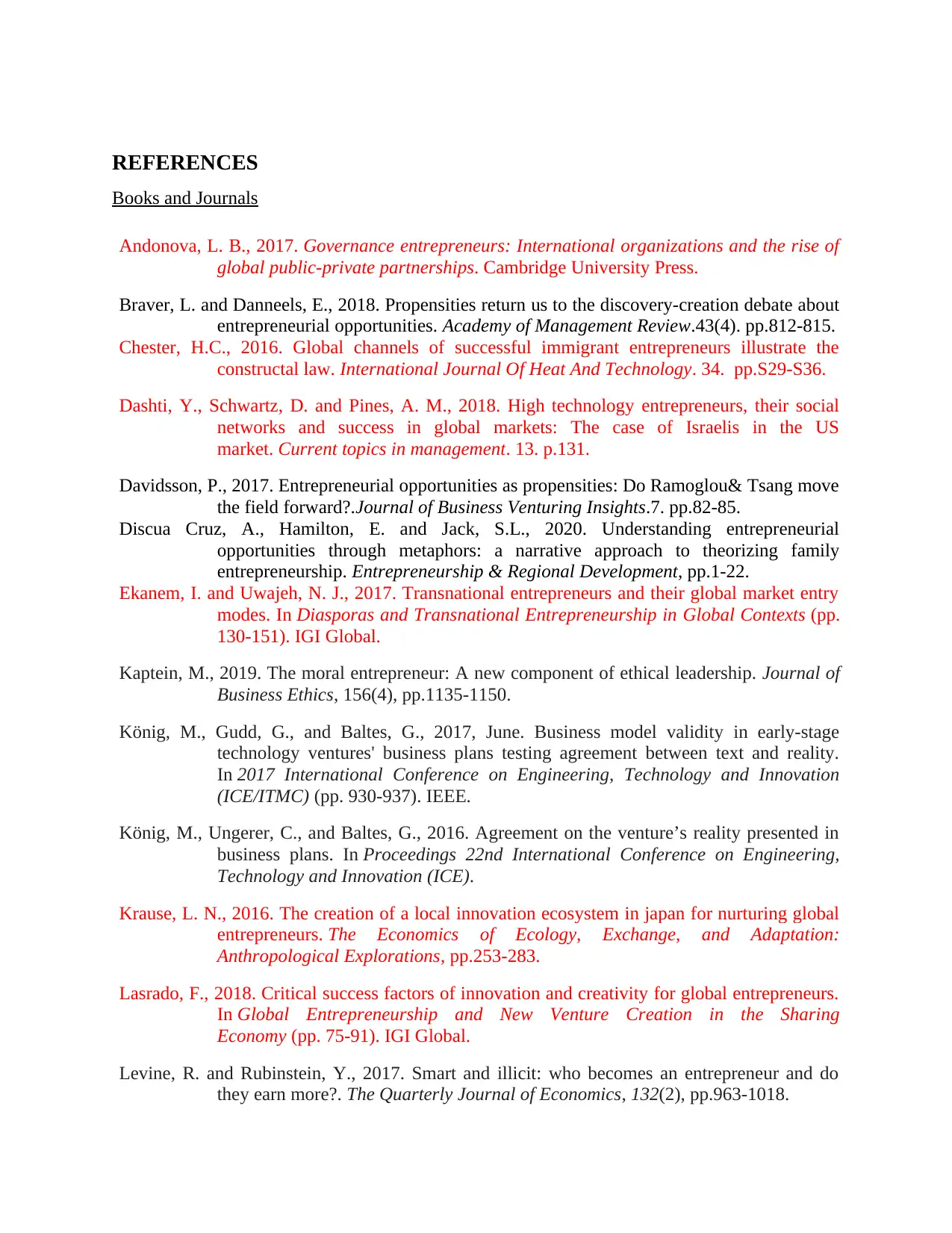
REFERENCES
Books and Journals
Andonova, L. B., 2017. Governance entrepreneurs: International organizations and the rise of
global public-private partnerships. Cambridge University Press.
Braver, L. and Danneels, E., 2018. Propensities return us to the discovery-creation debate about
entrepreneurial opportunities. Academy of Management Review.43(4). pp.812-815.
Chester, H.C., 2016. Global channels of successful immigrant entrepreneurs illustrate the
constructal law. International Journal Of Heat And Technology. 34. pp.S29-S36.
Dashti, Y., Schwartz, D. and Pines, A. M., 2018. High technology entrepreneurs, their social
networks and success in global markets: The case of Israelis in the US
market. Current topics in management. 13. p.131.
Davidsson, P., 2017. Entrepreneurial opportunities as propensities: Do Ramoglou& Tsang move
the field forward?.Journal of Business Venturing Insights.7. pp.82-85.
Discua Cruz, A., Hamilton, E. and Jack, S.L., 2020. Understanding entrepreneurial
opportunities through metaphors: a narrative approach to theorizing family
entrepreneurship. Entrepreneurship & Regional Development, pp.1-22.
Ekanem, I. and Uwajeh, N. J., 2017. Transnational entrepreneurs and their global market entry
modes. In Diasporas and Transnational Entrepreneurship in Global Contexts (pp.
130-151). IGI Global.
Kaptein, M., 2019. The moral entrepreneur: A new component of ethical leadership. Journal of
Business Ethics, 156(4), pp.1135-1150.
König, M., Gudd, G., and Baltes, G., 2017, June. Business model validity in early-stage
technology ventures' business plans testing agreement between text and reality.
In 2017 International Conference on Engineering, Technology and Innovation
(ICE/ITMC) (pp. 930-937). IEEE.
König, M., Ungerer, C., and Baltes, G., 2016. Agreement on the venture’s reality presented in
business plans. In Proceedings 22nd International Conference on Engineering,
Technology and Innovation (ICE).
Krause, L. N., 2016. The creation of a local innovation ecosystem in japan for nurturing global
entrepreneurs. The Economics of Ecology, Exchange, and Adaptation:
Anthropological Explorations, pp.253-283.
Lasrado, F., 2018. Critical success factors of innovation and creativity for global entrepreneurs.
In Global Entrepreneurship and New Venture Creation in the Sharing
Economy (pp. 75-91). IGI Global.
Levine, R. and Rubinstein, Y., 2017. Smart and illicit: who becomes an entrepreneur and do
they earn more?. The Quarterly Journal of Economics, 132(2), pp.963-1018.
Books and Journals
Andonova, L. B., 2017. Governance entrepreneurs: International organizations and the rise of
global public-private partnerships. Cambridge University Press.
Braver, L. and Danneels, E., 2018. Propensities return us to the discovery-creation debate about
entrepreneurial opportunities. Academy of Management Review.43(4). pp.812-815.
Chester, H.C., 2016. Global channels of successful immigrant entrepreneurs illustrate the
constructal law. International Journal Of Heat And Technology. 34. pp.S29-S36.
Dashti, Y., Schwartz, D. and Pines, A. M., 2018. High technology entrepreneurs, their social
networks and success in global markets: The case of Israelis in the US
market. Current topics in management. 13. p.131.
Davidsson, P., 2017. Entrepreneurial opportunities as propensities: Do Ramoglou& Tsang move
the field forward?.Journal of Business Venturing Insights.7. pp.82-85.
Discua Cruz, A., Hamilton, E. and Jack, S.L., 2020. Understanding entrepreneurial
opportunities through metaphors: a narrative approach to theorizing family
entrepreneurship. Entrepreneurship & Regional Development, pp.1-22.
Ekanem, I. and Uwajeh, N. J., 2017. Transnational entrepreneurs and their global market entry
modes. In Diasporas and Transnational Entrepreneurship in Global Contexts (pp.
130-151). IGI Global.
Kaptein, M., 2019. The moral entrepreneur: A new component of ethical leadership. Journal of
Business Ethics, 156(4), pp.1135-1150.
König, M., Gudd, G., and Baltes, G., 2017, June. Business model validity in early-stage
technology ventures' business plans testing agreement between text and reality.
In 2017 International Conference on Engineering, Technology and Innovation
(ICE/ITMC) (pp. 930-937). IEEE.
König, M., Ungerer, C., and Baltes, G., 2016. Agreement on the venture’s reality presented in
business plans. In Proceedings 22nd International Conference on Engineering,
Technology and Innovation (ICE).
Krause, L. N., 2016. The creation of a local innovation ecosystem in japan for nurturing global
entrepreneurs. The Economics of Ecology, Exchange, and Adaptation:
Anthropological Explorations, pp.253-283.
Lasrado, F., 2018. Critical success factors of innovation and creativity for global entrepreneurs.
In Global Entrepreneurship and New Venture Creation in the Sharing
Economy (pp. 75-91). IGI Global.
Levine, R. and Rubinstein, Y., 2017. Smart and illicit: who becomes an entrepreneur and do
they earn more?. The Quarterly Journal of Economics, 132(2), pp.963-1018.
Paraphrase This Document
Need a fresh take? Get an instant paraphrase of this document with our AI Paraphraser
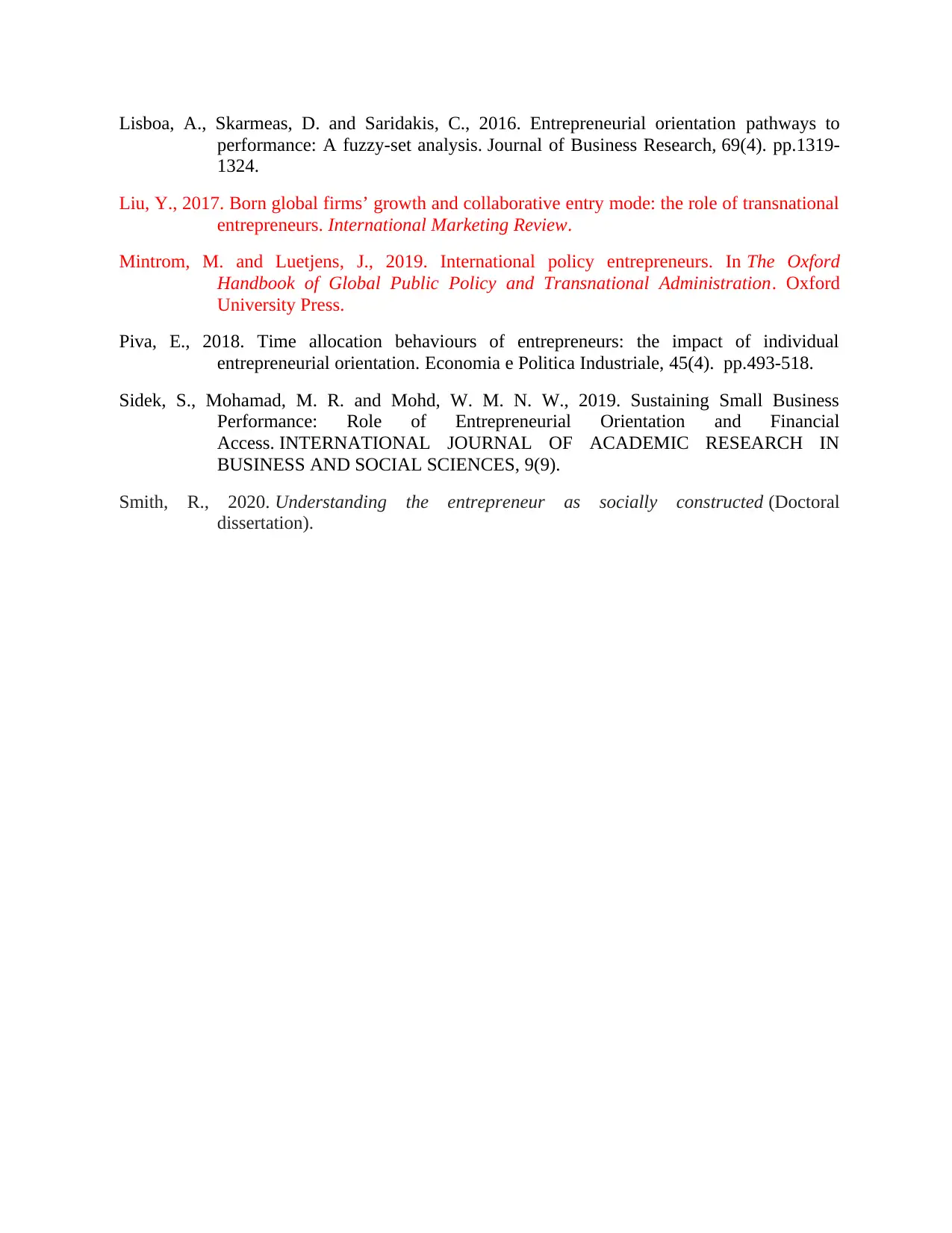
Lisboa, A., Skarmeas, D. and Saridakis, C., 2016. Entrepreneurial orientation pathways to
performance: A fuzzy-set analysis. Journal of Business Research, 69(4). pp.1319-
1324.
Liu, Y., 2017. Born global firms’ growth and collaborative entry mode: the role of transnational
entrepreneurs. International Marketing Review.
Mintrom, M. and Luetjens, J., 2019. International policy entrepreneurs. In The Oxford
Handbook of Global Public Policy and Transnational Administration. Oxford
University Press.
Piva, E., 2018. Time allocation behaviours of entrepreneurs: the impact of individual
entrepreneurial orientation. Economia e Politica Industriale, 45(4). pp.493-518.
Sidek, S., Mohamad, M. R. and Mohd, W. M. N. W., 2019. Sustaining Small Business
Performance: Role of Entrepreneurial Orientation and Financial
Access. INTERNATIONAL JOURNAL OF ACADEMIC RESEARCH IN
BUSINESS AND SOCIAL SCIENCES, 9(9).
Smith, R., 2020. Understanding the entrepreneur as socially constructed (Doctoral
dissertation).
performance: A fuzzy-set analysis. Journal of Business Research, 69(4). pp.1319-
1324.
Liu, Y., 2017. Born global firms’ growth and collaborative entry mode: the role of transnational
entrepreneurs. International Marketing Review.
Mintrom, M. and Luetjens, J., 2019. International policy entrepreneurs. In The Oxford
Handbook of Global Public Policy and Transnational Administration. Oxford
University Press.
Piva, E., 2018. Time allocation behaviours of entrepreneurs: the impact of individual
entrepreneurial orientation. Economia e Politica Industriale, 45(4). pp.493-518.
Sidek, S., Mohamad, M. R. and Mohd, W. M. N. W., 2019. Sustaining Small Business
Performance: Role of Entrepreneurial Orientation and Financial
Access. INTERNATIONAL JOURNAL OF ACADEMIC RESEARCH IN
BUSINESS AND SOCIAL SCIENCES, 9(9).
Smith, R., 2020. Understanding the entrepreneur as socially constructed (Doctoral
dissertation).
1 out of 11
Related Documents
Your All-in-One AI-Powered Toolkit for Academic Success.
+13062052269
info@desklib.com
Available 24*7 on WhatsApp / Email
![[object Object]](/_next/static/media/star-bottom.7253800d.svg)
Unlock your academic potential
Copyright © 2020–2025 A2Z Services. All Rights Reserved. Developed and managed by ZUCOL.





